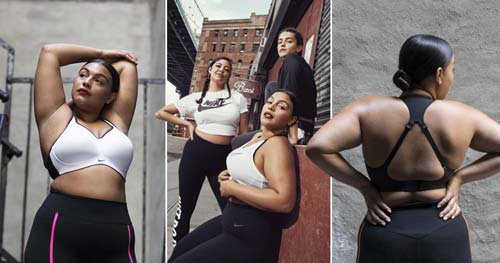The rise of the plus-size modeling industry has been gaining steady traction in recent years and shows no signs of slowing down anytime soon.
Huge global fashion brands are coming out with dedicated plus-size ranges and using more plus-size models on the runway, which is significant for an industry that is notorious for being the pioneers of the unhealthy size 0 obsession.
This year Nike launched their first plus-size sportswear range, with sizes ranging between XL to 3XL and Sports Illustrated debuted their size-inclusive swimwear collection, featuring models up to size 20 .
Plus-size models are also increasingly signed by more major modeling agencies than ever before.
Tess Holliday, US size 22 model (AUS size 26), has 1.5 million followers on Instagram and is one of the first plus-size models to be signed to a major modeling agency (Milk Model Management).
Plus-size modeling and its proponents declare the movement as demonstrating ‘body positivity’, encouraging women of all sizes to be proud of their figure.
On the flipside, plus-size models and the brands who cater to plus-size women, often receive vitriol by many who argue that mainstream plus-size modeling is dangerous, particularly when obesity has reached epidemic proportions.
While I see the value in each of these viewpoints, my opinion is more inclined to the latter.
People are quick to reduce the critics’ arguments to ‘fat shaming’. And perhaps it would be, if we weren’t living in a time where obesity causes 300,000 deaths annually in the US alone. Obesity rates continue to rise every year and it’s important that we as consumers put our money towards promoting the right, responsible message.
It’s essential to promote self-acceptance, but lauding individuals for being clinically obese are two very distinct issues.
If we recognize that the fashion industry’s use of stick-thin, starved models isn’t right, how is their use of extremely overweight models any different? Why must we swing to the extreme end of the spectrum? Why can we not find a happy, healthy middle ground.
Instead of pressuring brands to create plus-size lines and extending fame to obese influencers, more money and effort should be put towards supporting obese individuals who wish to lose weight, stay fit and take ownership of their wellbeing.

![5 Reasons You Should Travel Alone Airplane [image source: chau nguyen/ http://thedevilhatessweatpants.blogspot.com.au ], crowd ink, crowdink, crowdink.com, crowdink.com.au](https://crowdink.com/wp-content/uploads/2016/08/Chau-airplane-218x150.jpg)




























![5 Reasons You Should Travel Alone Airplane [image source: chau nguyen/ http://thedevilhatessweatpants.blogspot.com.au ], crowd ink, crowdink, crowdink.com, crowdink.com.au](https://crowdink.com/wp-content/uploads/2016/08/Chau-airplane-100x70.jpg)


